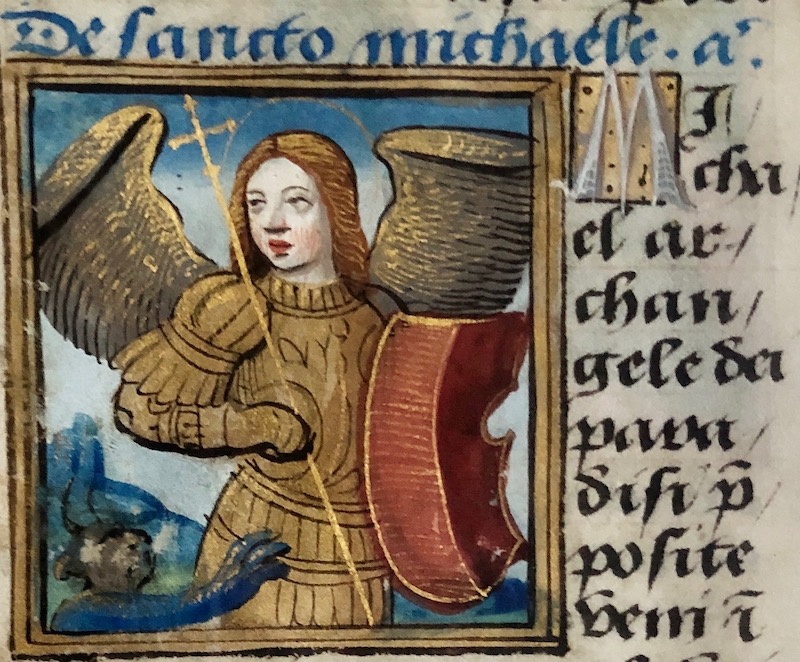It’s St Michael’s Day tomorrow and I couldn’t let my patron’s feast pass without a column in his honour. St Michael the Archangel was – and still is – the most famous of all God’s angels. He was venerated as the commander of the angelic armies, a holy healer, a protector of high places and as a companion during our final journey between this world and the next. With so many talents, it’s easy to understand why Michael was among medieval Europe’s most popular and widely depicted saints.
There are sound Scriptural foundations to St Michael’s veneration, or to be nerdy, his cult. Michael is mentioned in the Book of Daniel as one of the chief princes of the heavenly host and as special protector of Israel. In Revelations, Michael is God’s triumphant champion in the celestial battle between the forces of good and evil.
He was also a favourite in Biblical Apocrypha – early Christian writings not accepted as part of the Bible. Descriptions of Michael in numerous apocryphal texts such as the Testament of Abraham and the Life of Adam and Eve, led to him acquiring a special association with water. His nascent Christian cult in what’s now Greece and Turkey was focused on fountains and springs, especially those credited with healing powers. The archangel was said to have sanctified several of these watery places with an appearance and Constantine the Great, the first Christian Roman Emperor (d. 337), built a shrine to the saint – the Michaelion – in one such location.
Veneration of Michael in Western Europe was turbocharged by a series of visions of the archangel. Three are said to have occurred at Mount Gargano in southeast Italy during the fifth century, the holy mountain becoming a centre of his cult in the following centuries.
Another apparition occurred in seventh century Rome. During an outbreak of the plague, Pope Gregory the Great (d. 664) witnessed the angel standing atop the tomb of the Emperor Hadrian. The pontiff descried the angel sheathing his bloody sword, a sure sign of Michael’s intervention to save the city from the pestilence. The location of the apparition was named Castel Sant’Angelo in honour of the event, a name it rejoices in to this day.
The archangel also graced northern Europe with visits, the most famous in 709 when he appeared on the summit of a mountainous outcrop off the Normandy coast called forever after Mont Saint-Michel. A similar vision was the reason for the naming of St Michael’s Mount off the Cornish coast. Both these holy hills became the location of monasteries.
You’ll have noticed a common theme here, with Michael prone to making himself manifest in lofty locations. This association between the archangel and high places endured throughout the Middle Ages: the church atop Glastonbury Tor was dedicated to the saint, so too a chapel on a hillock to the south of Fountains Abbey. Our medieval ancestors would have readily understood the reason.
As explained in the Golden Legend, a collection of saints’ lives composed in 13th-century Italy, Lucifer and his fellow fallen angels inhabited the air “between heaven and earth” and “fly around us like flies”. Luckily, the ever-vigilant Michael, resplendent with wings composed of rainbow coloured feathers, was there to swat these foul fiends with his drawn sword. His sculpted image was placed on many a tower to deter the buzzing forces of evil and reassure the faithful of his protective presence.
Michael’s sacred services were also available for the dying. The archangel stood ready to do battle with Satan for the souls of the recently departed. “Then shall ye all knel adowne, and pray to Seynt Michaell, that he apere to you, and when ye shall passe out of this world, and defend you from your emmyse, and bring you to the joye of paradise,” wrote John Mirk, a canon and later prior of Lilleshall Abbey, an Augustinian monastery in Shropshire, in the years around 1400.
Because of these deathbed services, Michael is regarded as a “psychopomp”, a trusty guide for souls on their journey from Earth to the afterlife. And once a soul had reached the Pearly Gates, it was weighed in scales held by the archangel to determine if its virtue was sufficient to warrant passage to everlasting bliss. It doesn’t take too much imagination to work out why cemeteries and funerary chapels across Europe were dedicated to St Michael.
Pilgrims flocked to the saint’s shrine at Mount Gagano, many etching their name into the rock close to where St Michael was said to have appeared. Among those making the pious peregrination was a group of Norman knights. Their visit to the holy mountain in the early 11th century was the catalyst for a chain of events that resulted in the Norman conquest of Sicily.
Stones chipped from the site of Michael’s apparitions at Gargano were disseminated as sacred relics. Two found their way to Battle Abbey, William the Conqueror’s great penance for, and memorial to, his victory at the Battle of Hastings in 1066. The angel’s sacred military associations appealed to the warrior elites of medieval Europe. From the time of Charlemagne onwards, Michael was the official protector of the Holy Roman Empire and chivalric orders were founded under his patronage.
For centuries, artists have found inspiration in Michael’s multiple roles: peaceful angel in the glorious twelfth century mosaics at Cefalù Cathedral, Sicily; a holy warrior on multiple late medieval East Anglian rood screens; a weigher of souls in Hans Memling’s terrifying fifteenth century panel painting of the Last Judgement.
His feast on 29 September commemorates the fifth century dedication of a basilica in his honour in the outskirts of Rome. The English name for the feast is Michaelmas. One of the historic “quarter days” when the rent had to be paid, it also gave its name to the academic and legal terms that start at this time of year. It’s not usual for there to be a spell of fine, warm weather in late September. We now usually call this an Indian Summer but in bygone ages it was labelled a Michaelmas Summer – surely an appellation worthy of revival in these times of increased sensitivity to the use of language. It might even be something that both sides in the culture war, self-appointed traditionalists and combative decolonisers, could agree upon. That would be something else to thank St Michael for.



 Loading ...
Loading ...
What do you think?
You can post as a subscriber user ...
User comments (0)